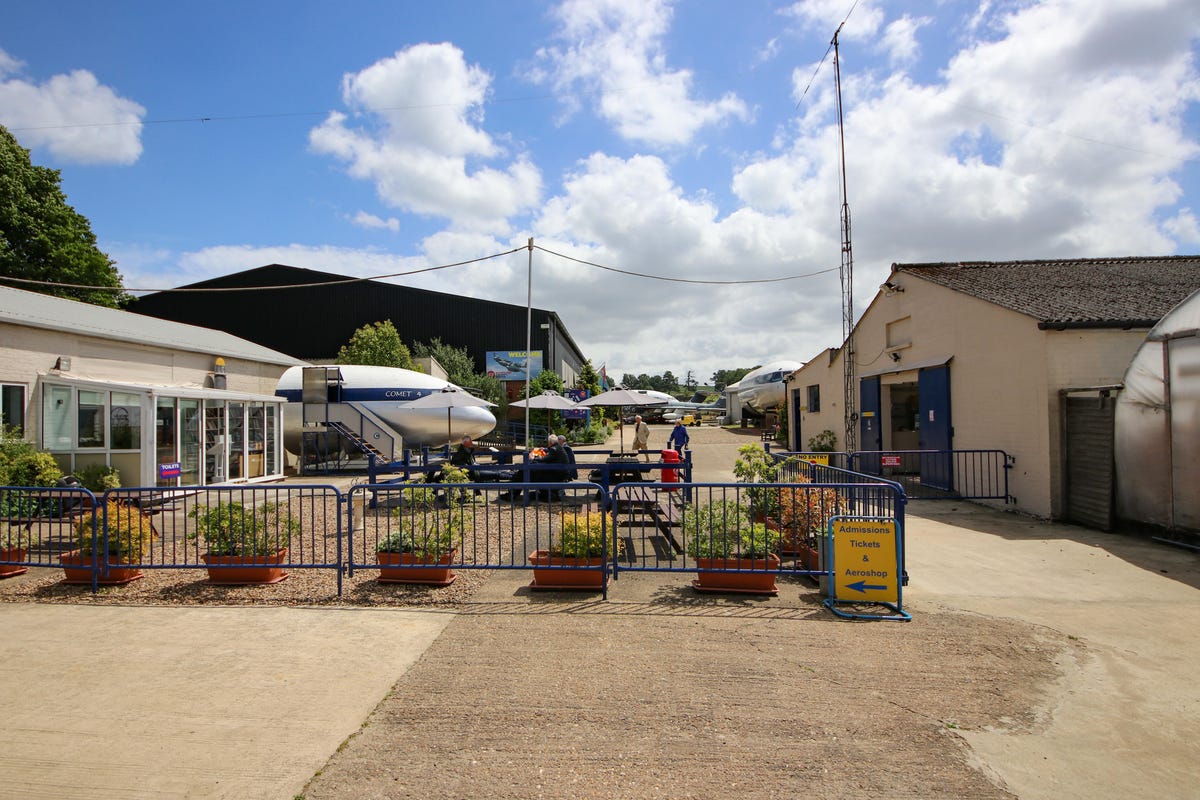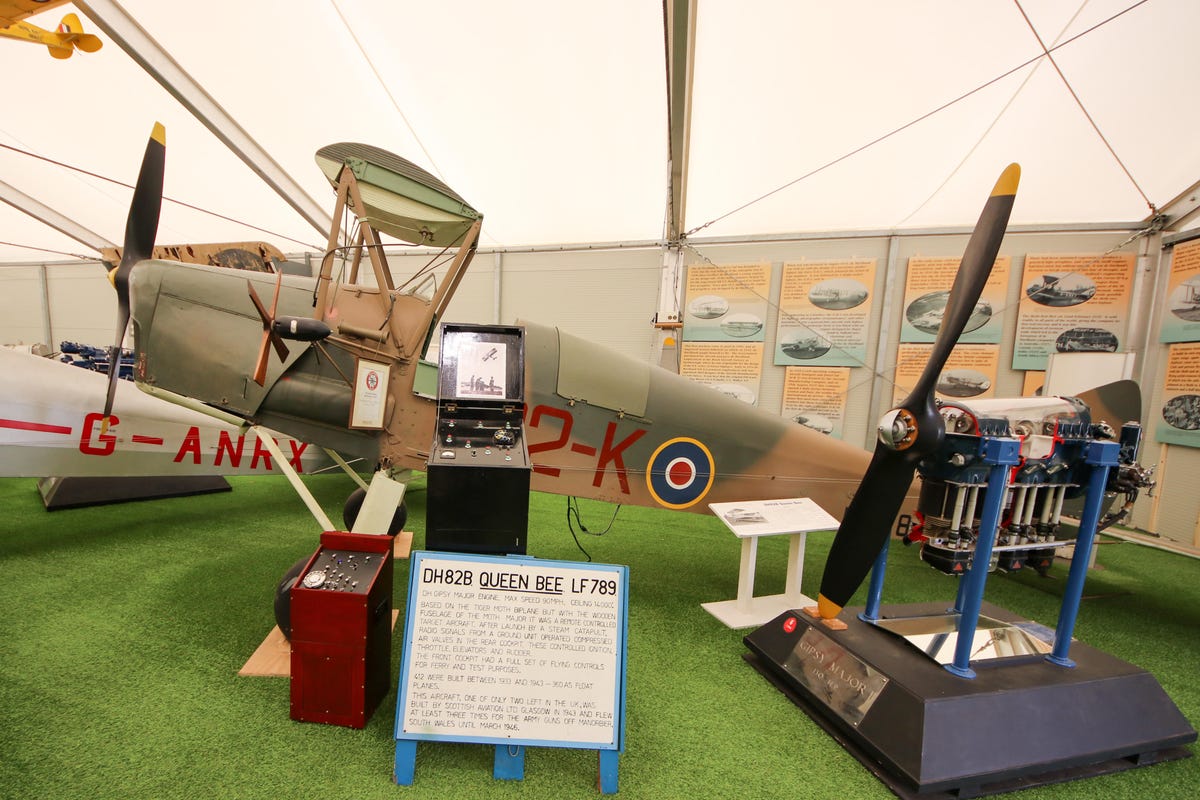
de Havilland Aircraft Museum
Set in the countryside north of London, the de Havilland Aircraft Museum is dedicated to the legendary aircraft designer and the company he founded.
For the full story behind this tour, check out Vixens, Vampires and Mosquitos: Check out the legendary planes of the de Havilland Aircraft Museum.
Seating for few
Eight passengers could cruise in comfort up to 187 mph/301 kph.
Retro
If the huge windows and cool seat coverings didn't give it away, this cockpit sure shows its post-war origins.
4 by the door
Just adjacent to the gift shop and cafe is the nose of a Comet 4. The cockpit inside is beautifully restored.
Seating for four
Given how similar it looks to modern aircraft, it's easy to forget how far technology has come. Not only does the Comet have a flight engineer, but a navigator as well. The navigator doubled as the radio operator.
One-third of a Trident
The front portion of the DH 121 Trident, a groundbreaking plane with a disappointing history.
Too small
The initial Trident seated only 101 passengers. Later models sat 180, but by then Boeing's similar 727 dominated the market. Wendover Productions has a great video on why we don't see trijets anymore.
Crewed in style
Apparently this bathroom was just for the crew. Don't see that much anymore.
3+1
The Trident was 10 years after the Comet. There's still an engineer, but the radio operator/navigator is gone. In the middle of the console, the orange rectangle is a moving map.
SPO
The Systems Panel Operator had a lot of systems to operate on his panel.
Original Comet
This is the only surviving example of a first-generation Comet with the infamous square windows.
From the inside
A closer look at the deadly square windows. Unbeknownst to engineers at the time, the square windows would create significant stress in the surrounding metal, causing rapid fatigue and eventually structural failure. This aircraft was one of three intended for testing, but the first two were enough to determine what was happening.
You are now free to smoke
Period seats on the right side of the plane, images of the models troubles on the left. Hard to see, but the seats have ash trays in the armrests.
Under construction
The museum is working to restore the cockpit to reflect how it looked in its day.
Not hip to be square
The square windows from the outside. Real Engineering has a great video on why the square windows failed.
Mossie
One of several Mosquitos, probably de Havilland's most famous design. These planes were absolute beasts.
Wood
Nicknamed "The Wooden Wonder" it was, as you'd figure from that name, made almost entirely of wood. This is actually the prototype from 1940. It was built nearby, and has been preserved here since 1959.
Need for speed
Its light weight and massive engines made it one of the fastest planes of its day. This is the only surviving World War II prototype in the world. Inception to flying prototype took less than a year.
Multi-role
It was such a versatile platform, it was used as a bomber, a fighter, an intruder and even for high-speed photo reconnaissance.
Firepower
This Mk.VI had four Browning .303 machine guns and four 20mm canons.
Seating for two... barely
They did a great job on the restoration. It looks brand new, not 61 years removed from the factory.
In the back
Behind the main hangars sit some of the larger aircraft.
Booms
Twin-boom aircraft are by far my favorite. Is that just me? The Vampire was the second jet-powered aircraft used by the RAF.
Two stick
The trainer version was adapted from the two-seat night fighter, but is largely the same as other Vampires.
Descendants
Design work was started by Hawker Siddeley in the early '70s, who had bought de Havilland 10 years prior. By the time it went into production, Hawker Siddeley had become British Aerospace.
World flier
Built in 1983, this 146-100 flew for airlines all over the world, including Brazil, Canada, the US, the UK and more.
125
The midsize biz jet 125 started life at de Havilland, but was developed and built by Hawker Siddeley after they were bought out. It had an impressive run, with production finally ending in 2013.
Honeycomb
A cross-section of the structure of the 125's wing, an aluminum honeycomb for strength and light weight.
Cozy?
The small cabin of the 125 is surprisingly cozy, with its shag carpet and yellow tones. It didn't feel much larger than the Cirrus Vision Jet I flew last year.
First of its kind
This is actually the first production 125. Once it entered its service life, it was an engine development testbed, and was a communications aircraft for Concorde engine development.
Teal bird
A de Havilland Heron, which was developed from the Dove you saw earlier. Longer, with double the engines, this Mk.2 version had retractable landing gear. It flew in Scotland for 13 years until 1969.
When you need to go...
Talk about an efficient use of space. The entryway into the cabin doubles as the bathroom.
Beautiful view
This is one of the airiest cabins I've ever been in. The windows are enormous. This Mk.2D variant had a more upscale interior.
Slow and steady
With an unpressurized cabin and four 250hp inline-6 engines, the Heron offered an adequate 183 mph/295 kph top speed.
Autogyro
This Cierva C.24 is a unique aircraft, built by the de Havilland company, but using a design by Juan de la Cierva. Most of the parts are from in-era (1930s) de Havilland aircraft like the Puss Moth. As an autogyro, the rotor is unpowered and must have forward motion to maintain lift.

Protodrone
The DH.82 Queen Bee, one of the first remote-controlled target aircraft. Essentially an early model drone, some believe this is where that term came from.
Protocontrols
It's fascinating to see these early controls, decades before joysticks or PlayStation controllers became ubiquitous. The controls worked using compressed air created by an air pump, which was powered by the wooden propeller you see in the upper left.
Flyable
Unlike modern drones, this one could be flown in person, if necessary.
Chipmunk
The Chipmunk was a two-seat trainer, designed by de Havilland Canada. This example was built in the UK. All told, nearly 1,300 were built.
Tiger Moth
A wildly successful design, de Havilland built around 9,000 Tiger Moths, most intended as training aircraft.
Simplicty
This example was used as a trainer in WWII, then as a crop duster post-war. It flew for 22 years, and was restored by the museum in the '90s.
Interview with...
This Vampire is slightly older than the T.11 outside. Built in 1949, it served with the Swiss Airforce. Its Goblin 3 turbojet was good for a 548 mph/882 kph top speed.
Eject!
The Swiss added a Martin-Baker ejection seat in 1960.
And so ends our tour of the de Havilland Aircraft Museum. Check out Vixens, Vampires and Mosquitos: Legendary planes of the de Havilland Aircraft Museum for more info.

